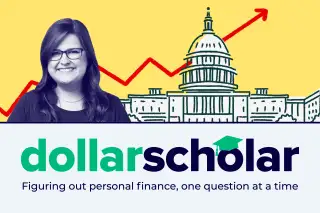Dollar Scholar Asks: Is the Fed About to Stop Raising Interest Rates?

This is an excerpt from Dollar Scholar, the Money newsletter where news editor Julia Glum teaches you the modern money lessons you NEED to know. Don't miss the next issue! Sign up at money.com/subscribe and join our community of 160,000+ Scholars.
You know that moment when you’re riding a roller coaster that’s just reached the top of the first drop and you’re paused there, teetering? You’re anxious and excited. You can see the downward swoop of the track ahead but you don’t know what to expect: when you’ll finally lurch forward, how terrifying it’ll be... or whether you’re going to throw up?
That’s where we are with the Federal Reserve right now.
The U.S. central banking system has been raising rates for over a year, taking the federal funds rate from 0 to 0.25% at the start of March 2022 to a target range of 5 to 5.25% last month. The 10 consecutive rate hikes have all been in hopes of curbing inflation — and soon, they may taper off.
The nation's record-high inflation has been slowly abating, and the recent bank drama has helped to cool down the economy a bit. But I’ve become accustomed to living in a high-interest-rate environment. And now that I’m peering over the edge, I’m getting worried.
The first thing to realize is that nobody knows exactly what’s next, according to David Bieri, an associate professor of economics at Virginia Tech. Even Fed Chair Jerome Powell has been playing it coy, saying at a May news conference that “a decision on a pause was not made,” though “we may not be far off.”
Bieri says one complicating factor is that the Fed has a dual mandate: to promote a healthy economy (slash labor market) and maintain stable prices. Right now, he points out, “inflation is still way above the 2% where they want it to be,” and there’s a “distinct possibility of a recession on the horizon.”
That puts the Fed in a tight spot, especially because it only has a blunt tool at its disposal.
“You have opposing forces,” Bieri says. “If you want to fight inflation, you have to keep rates high. If you want to fight a recession — or fight financial instability — you potentially need to lower rates. So what do you do?”
When the Fed raises rates, like it has been, it makes borrowing money more expensive, indirectly driving up mortgage rates, savings rates and the cost of credit card borrowing.
If it were to slash them, making borrowing cheaper, the opposite could happen: Demand for goods and services could surge, fueling asset price bubbles bound to burst and generating future problems.
Despite the last year of hikes, inflation has proven stubborn. It reached 4.9% in April, and Alex Horenstein, an associate professor of economics at the University of Miami, says he doesn’t think it’ll drop drastically anytime soon.
As such, the Fed’s hands are tied.
“I don't see the Fed being able to decrease interest rates when inflation is around 5%,” Horenstein says. “Once the inflationary process starts, it's very difficult to stop without hurting the economy.” (Which would be rough right before an election.)
Given this position, he says he’d recommend thinking of our current situation as “the new normal.” The Fed will probably take its foot off the gas and keep rates around 5%, which would amount to little change for consumers like me.
“The years of mortgages at 2%? Those are not coming [back] anytime soon,” Horenstein says, adding that car loan rates and savings yields will probably stay elevated, too.
That equates to a pause, not a pivot, as Gargi Chaudhuri, head of BlackRock's iShares investment strategy in the Americas, told Money recently. This is an important distinction. A pause is a quick break, historically lasting about 10 months on average; a pivot would mean the Fed changing course and starting to decrease rates.
“We think that the Fed will just stop here and see how the economy evolves, how inflation evolves, how the labor market evolves,” Chaudhuri added.
While I’m not-so-patiently waiting for the Fed to make a move (or make a move indicating which move it’s going to make), Chaudhuri said to consider investing in healthy, stable companies that have proven profitable.
Bieri suggests I take a look at my own liquidity management. In other words, I should run the numbers on how long I could pay my bills if I were to lose my income. Because borrowing is expensive — and, if the Fed pauses, will likely remain expensive in the near future — I want to make sure I have cash on hand.
“It’ll be a long time before you see 0% APR again,” he adds.
What the Fed does next is anyone’s guess. Despite its aggressive approach over the past year, the central bank may simply pause and wait for the dust to settle (and for the 2024 election to pass) before enacting policies that could influence the economy.
If that happens, there won’t be anything major that impacts my financial life.
“[Do] not expect dramatic changes in the immediate term unless something very bad happens — or very good,” Horenstein says.
More from Money:
A ‘Credit Crunch’ Is Looming. Here’s How It Could Affect Your Wallet
Your Emergency Fund Is Probably Too Small Now (Thanks, Inflation)